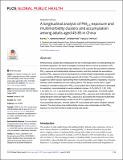Files in this item
A longitudinal analysis of PM2.5 exposure and multimorbidity clusters and accumulation among adults aged 45-85 in China
Item metadata
| dc.contributor.author | Hu, Kai | |
| dc.contributor.author | Keenan, Katherine | |
| dc.contributor.author | Hale, Jo Mhairi | |
| dc.contributor.author | Liu, Yang | |
| dc.contributor.author | Kulu, Hill | |
| dc.date.accessioned | 2022-07-07T13:30:27Z | |
| dc.date.available | 2022-07-07T13:30:27Z | |
| dc.date.issued | 2022-06-29 | |
| dc.identifier | 280298566 | |
| dc.identifier | bd12815c-01f0-4040-82fe-c659ff91aecc | |
| dc.identifier.citation | Hu , K , Keenan , K , Hale , J M , Liu , Y & Kulu , H 2022 , ' A longitudinal analysis of PM 2.5 exposure and multimorbidity clusters and accumulation among adults aged 45-85 in China ' , PLOS Global Public Health , vol. 2 , no. 6 , e0000520 . https://doi.org/10.1371/journal.pgph.0000520 | en |
| dc.identifier.issn | 2767-3375 | |
| dc.identifier.other | RIS: urn:CB48DFB0BB5D70ACABACC76679305630 | |
| dc.identifier.other | ORCID: /0000-0003-1343-3879/work/115309165 | |
| dc.identifier.other | ORCID: /0000-0001-8808-0719/work/115309309 | |
| dc.identifier.other | ORCID: /0000-0002-9670-1607/work/115309418 | |
| dc.identifier.uri | https://hdl.handle.net/10023/25624 | |
| dc.description | Funding: This study is supported by China Scholarship Council (CSC No. 201703780011), People’s Republic of China, and Population and Health Research Group (PHRG), School of Geography and Sustainable Development, University of St Andrews, United Kingdom. PM2.5 data in this study is from the work of Yang Liu, supported by the National Institute of Environmental Health Sciences of the National Institutes of Health, USA (Grant No. 1R01ES032140). This study is also supported by the Centre for Population Change (CPC) (ES/R009139/1). | en |
| dc.description.abstract | While previous studies have emphasised the role of individual factors in understanding multimorbidity disparities, few have investigated contextual factors such as air pollution (AP). We first use cross-sectional latent class analysis (LCA) to assess the associations between PM2.5 exposure and multimorbidity disease clusters, and then estimate the associations between PM2.5 exposure and the development of multimorbidity longitudinally using growth curve modelling (GCM) among adults aged 45–85 in China. The results of LCA modelling suggest four latent classes representing three multimorbidity patterns (respiratory, musculoskeletal, cardio-metabolic) and one healthy pattern. The analysis shows that a 1 μg/m3 increase in cumulative exposure to PM2.5 is associated with a higher likelihood of belonging to respiratory, musculoskeletal or cardio-metabolic clusters: 2.4% (95% CI: 1.02, 1.03), 1.5% (95% CI: 1.01, 1.02) and 3.3% (95% CI: 1.03, 1.04), respectively. The GCM models show that there is a u-shaped association between PM2.5 exposure and multimorbidity, indicating that both lower and higher PM2.5 exposure is associated with increased multimorbidity levels. Higher multimorbidity in areas of low AP is explained by clustering of musculoskeletal diseases, whereas higher AP is associated with cardio-metabolic disease clusters. The study shows how multimorbidity clusters vary contextually and that PM2.5 exposure is more detrimental to health among older adults. | |
| dc.format.extent | 20 | |
| dc.format.extent | 1420029 | |
| dc.language.iso | eng | |
| dc.relation.ispartof | PLOS Global Public Health | en |
| dc.subject | RA0421 Public health. Hygiene. Preventive Medicine | en |
| dc.subject | NDAS | en |
| dc.subject | SDG 3 - Good Health and Well-being | en |
| dc.subject.lcc | RA0421 | en |
| dc.title | A longitudinal analysis of PM2.5 exposure and multimorbidity clusters and accumulation among adults aged 45-85 in China | en |
| dc.type | Journal article | en |
| dc.contributor.sponsor | Economic & Social Research Council | en |
| dc.contributor.institution | University of St Andrews. Population and Health Research | en |
| dc.contributor.institution | University of St Andrews. School of Geography & Sustainable Development | en |
| dc.contributor.institution | University of St Andrews. Sir James Mackenzie Institute for Early Diagnosis | en |
| dc.identifier.doi | https://doi.org/10.1371/journal.pgph.0000520 | |
| dc.description.status | Peer reviewed | en |
| dc.identifier.grantnumber | ES/R009139/1 | en |
This item appears in the following Collection(s)
Items in the St Andrews Research Repository are protected by copyright, with all rights reserved, unless otherwise indicated.

